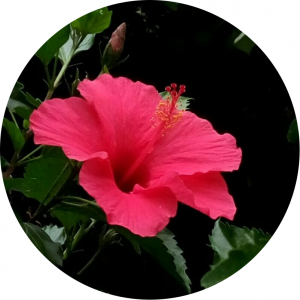Tao language, also known as “Yami language” (Glottolog code: yami1254), is the only language among Taiwan aboriginal languages that is not classified as a Formosan language [1]. The same as many other ethnic labels of Taiwan indigenous groups, “Tao” means “people” in their language. Although the identity label “Tao” is well known among Taiwanese people, “Yami” remains the common ethnic label among academic researches.
達悟族,舊稱雅美(Glottolog code : yami1254),是台灣唯一一個不屬於福爾摩沙語系的原住民語。如之前的文章所述,台灣的原住民族,族稱多半都是「人類」的意思。 達悟族的族名(Tao),不意外的也是指「人類」。「達悟」這個族稱雖然在台灣已經被廣泛地接受了,但學術界,特別是語言學以及族群遺傳學使用的依舊是使用舊稱「雅美」。
Tao people are residents of Lanyu island, Taiwan. They refer their habitat “Pongso no Tao”. Pongso*¹ means island, no is the genitive marker of Tao. Some articles online translate “Pongso no Tao” as “Island of mankind”, but the precise translation of “Pongso no Tao” should be “Island of Tao people”.
達悟族長久居住於蘭嶼島上,蘭嶼在達悟語(雅美語)中是Pongso no Tao。 Pongso*¹是島嶼的意思,no是屬格的標記,雖然網路上為求浪漫翻譯成「人之島」,但Tao在這裡是族稱,最好中規中矩的翻譯成達悟族的島,以表示這是達悟族的居住地。
Although I am fascinated by Tatala (canoe) and flying fish festival, the unique cultural icons of Tao group, my motivation to write a series of articles about this group is the studies about Tao language and their genetic affiliation. I often wonder the origin of Tao people and its mysterious relation to the history of Austronesian dispersal. Does this island serve as a rest stop between Taiwan and Philippine along the highway of Kuroshio Current? Or is this group of people the trace of the Austronesian expansion?
拼板舟與飛魚季慶典大概是對達悟族最直接的聯想,但啟發筆者寫下一系列與達悟族相關的文章卻是現有關於語言分類與基因多樣性的研究,每一個線索對於蘭嶼達悟族在南島語民族遷徙史中所佔有的地位更增添了一分神秘感:是台灣與菲律賓的中繼站?還是南島語族擴張的過程中遺留在汪洋大海中的一群人?
The language classification
達悟語的語言分類
There are two main branches of
南島語係可分成兩大分支,福爾摩沙語族與馬來-玻里尼西亞語族*²。目前已記載的台灣原住民語言都是屬於福爾摩沙語族,只有達悟語是屬於馬來-玻里尼西亞語族,目前在Glottolog上的分類是Batanic語族中的Yami-Itbayat語支。歷史語言學上的語言分類,通常是經過比較詞彙而來的*³。通過找尋同源詞以及比較同源詞的數量,可以推估出兩個或多個語言之間的親緣以及建構祖語(Proto-language)。 換句話說,歷史語言學家認為達悟語與Batanic語族中的其他三個語言(Itbayat, Ivatan, Babuyan)有一個共同的祖語[1]。
So now the question is, can we infer that Tao (Yami) people are the descendents of Philippine aboriginal groups who migrated northward? Since three out of four Batanic languages are spoken in Batan Island in Philippine.
Batanic語族中總共有四個語言: Itbayat, Ivatan, Babuyan還有達悟語;三個語言都是屬於菲律賓北方巴丹群島的原住民語言,只有達悟族是在台灣。如果說達悟語是屬於Batanic語族,而其他三個Batanic語言都是屬於菲律賓的原住民族語言,可以由此推論達悟族其實是菲律賓北部原住民族北漂的一支嗎?
This is the famous hypothesis of language-gene co-evolution, which was formally proposed by a population geneticist, Luigi Luca Cavalli-Sforza*⁴ [2]. In brief, the co-evolution hypothesis states that language differentiation and population speciation evolve in the same pattern, therefore, if the perfect/accurate language and population trees existed, the two trees should be identical. However, there are studies shown that the population speciation does not always go hand in hand together with language differentiation [3]. The underlying mechanisms to shape language variations and ethnic diversities are complex. From a linguistic aspect, every existing language underwent a series of sound change, semantic shift, lexical borrowing and so on. From the anthropology point of view, the formation of an ethnic group is also a complex process. Overall, searching for the root of Tao (Yami) people cannot merely rely on a piece of linguistic evidence, multiple clues are required to answer this question.
雖然從族群遺傳學家Luigi Luca Cavalli-Sforza開始,就一直有一派說法是相信族群分化與語言分化有密不可分的關係,這就是有名的「基因與語言共同演化假設」*⁴ [2]。簡而言之,如果世界上有完美的族群親緣關係樹以及語言分化樹,兩棵樹的分支應該是要一模一樣的。 但世界上有一些例子證明了族群的分化與語言的分化不是必然的因果關係[3]。因為促使族群分化與語言分化的機制都非常繁複。就語言學的角度來說,每一個語言都是經過一系列的聲變、意變、借詞才成為今日的模樣。從人類學的角度來說,一個族群的形成歷時長久且複雜的過程。單憑語言學的分類是不能斬釘截鐵的認為蘭嶼達悟族的起源就是來自於菲律賓Batan島的民族。所以,想知道達悟族的起源跟歷史地位,還需要加入其他的線索來輔助分析。
Next : The creation myth of Tao people
下一集:達悟族的起源神話
Footnote
*1.
*2. The classification of a language family is a hierarchy structure:
Macro family > Family > Group > Subgroup > Language
超語系 > 語系 > 語族 > 語支 > 語言
*3. Only words which are thought to be basic vocabulary are used to infer the genealogical relationship among languages. Historical linguists believe that basic vocabulary items are resistant to borrowing.
推估兩個或多個語言是否有共同祖語使用的是核心詞彙,也就是不容易被其他語言借走或是借來的詞彙。
*4. The idea that a population tree and a language tree should be identical was first mentioned by Darwin, in his book “On the Origin of Species”. This idea was adopted by Cavalli-Sforza and proposed the “ language-gene co-evolution hypothesis”.
Reference
[1] Ross, M. (2005). The
[2] Cavalli-Sforza, L. L. (1997). Genes, peoples, and languages. Proceedings of the National Academy of Sciences, 94(15), 7719-7724.
[3] Hunley K, Dunn M, Lindström E, Reesink G, Terrill A, et al. (2008) Genetic and Linguistic Coevolution in Northern Island Melanesia. PLOS Genetics 4(10): e1000239. https://doi.org/10.1371/journal.pgen.1000239
 Mei-Shin Wu.
Mei-Shin Wu. TDRP
TDRP